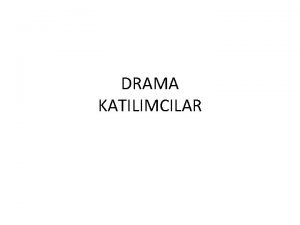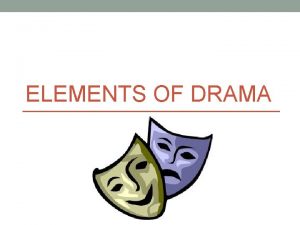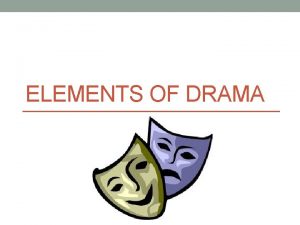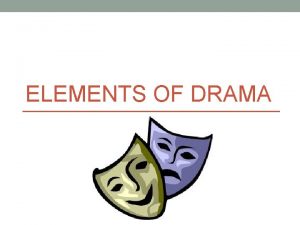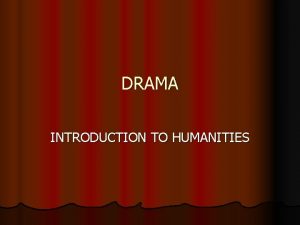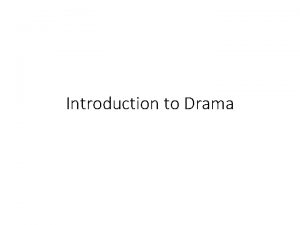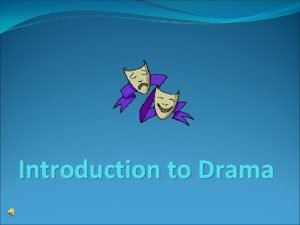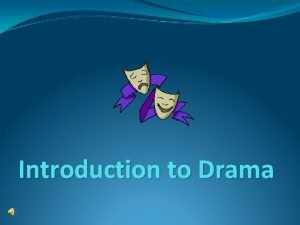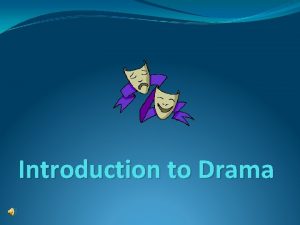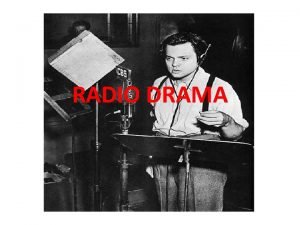Introduction to Drama What is drama The word




















- Slides: 20

Introduction to Drama

What is drama? The word drama comes from the Greek word for “action. ” Drama is written to be performed by actors and watched by an audience.

DRAMA Consists of two types of writing The dialogue that the characters speak The stage directions that tell the actors how to move and speak, describing the sets and props Can be presented in two ways As literature, the text of the play itself As performance, the production of the play in a theater

Two Types of Drama 1. Tragedy 2. Comedy shows the downfall or death of a tragic hero, or main character. In ancient Greek plays, the hero was a good person brought down by a tragic flaw, or defect in character. In a modern plays, the hero can be an normal person destroyed by an evil in society. emphasizes human greatness. often shows a conflict between opposite age groups , genders, or personality types. typical comedies involve confusion, jokes, and a happy ending. stresses human weaknesses.

A drama or play is a form of storytelling in which actors make the characters come alive through speech (dialogue) and action (stage directions). • Every performance of a play is different, even if the same actors perform the same play many times. • Performances are influenced by the audience. To be a part of an audience is different than reading a play alone. The response of the audience will also affect our own response. For example, we laugh louder when the rest of the audience is laughing, too.

How is a play written? The author of a play is called a playwright. Everything a playwright writes must appear onstage. A play in written form is called a script. The playwright must write the dialogue, or what the characters say to each other in conversation, as well as the stage directions, which tells how the play is to be performed.

Dialogue is what the characters say, and it is used to reveal their personalities = Character Traits. The name of the character who is to speak is listed usually in bold at the start of a line, followed by a colon. Every time the speaker changes, a new line is started. Dialogue is necessary in order to develop conflict and advance the plot.

Staging a play Drama is more than just the words on a page. The production of a play involves directing the way the characters move, what they wear, the lighting, and the scenery. Staging is the practice of putting on the play. Some of the details of staging may be included in the stage directions, however, the director and the producer take what the playwright has described and bring it to life with their own ideas.

Sets are the scenery, backdrops, and furniture that create the setting. A production may have different sets for different scenes. For example, some scenes may take place outside in the street, while others may take place in a character’s living room. Some scenes may take place during the day, while others may take place at night.

Props are things like books, telephones, dishes, and other items that actors use onstage during the performance to support the action.

Stage directions are notes in the script usually written in italics and enclosed in parentheses or brackets. They usually describe where and when a scene takes place (setting), how the characters should say their lines, and how the characters should move onstage. They may explain the character’s mood or how the character is feeling. Stage directions may also describe sets, costumes, props, lighting, and sound effects. Stage directions use certain terms to describe the stage. Look at the following slide and see how.

Take a look at a script and MARK THE TEXT! Preview text features. Read aloud the dialogue, using stage directions to understand the characters’ attitudes, emotions, and personalities. Read stage directions and imagine how the scene should be enacted. Mark the Text!

Audience Downstage Left Downstage Center Downstage Right Stage Left Center Stage Right Upstage Left Upstage Center Upstage Right

Dramatization A dramatization is a play that was once a novel, short story, folk tale, biography, or other type of writing. Some plays are completely new works. Other plays are adapted from novels, short stories, or even from nonfiction. A playwright takes scenes, characters, and action from an existing work and turns them into a play, or dramatizes them.

How is a play divided? A play is largely divided up into parts, or acts. The number of acts in a production can range from one to five, depending on how a writer structures the outline of the story. The length of time for an act to be performed can range from 30 to 90 minutes. Acts may be further divided into scenes; in classical theatre each regrouping between entrances and exits of actors is a scene, while today it describes a quick change of setting.

Remember-People Produce Plays The actors and actresses who perform the play are known as the cast. The people who build sets, manage lighting, or work backstage are called the crew.

Theater Etiquette All of the people involved in the production, both cast and crew, work very hard to be sure they give a great performance. It is the job of the audience members to help the performers give their best performance possible. The audience can do this by practicing the rules of theater etiquette, which is how the audience should behave when watching a play.

Rules of Theater Etiquette Be on time to theater. Turn off cell phones upon arrival. Be quite so other around you can hear the performance You should use the restroom before the show begins, and not get out of your seat while the show is being performed. You should not eat, chew gum, or drink any beverages while watching the show. While it is appropriate to respond to funny, shocking, or entertaining moments out loud, you should respect others around you and their enjoyment of the play by not responding with loud, inappropriate reactions.

When Should You Applaud? Stand applaud if you really thought the show was great. That is a called a standing ovation, and it honors the actors who worked so hard to give a great performance. It is customary to applaud at the end of songs, and at the curtain call, when the actors come out to take their final bows. Throughout the show, audience members may choose to applaud when something particularly 0 utstanding has just been performed. Do not whistle or scream out to the performers except for a Bravo.

Enjoy the Show! (Whether you are reading drama or watching a performance)
 Hình ảnh bộ gõ cơ thể búng tay
Hình ảnh bộ gõ cơ thể búng tay Slidetodoc
Slidetodoc Bổ thể
Bổ thể Tỉ lệ cơ thể trẻ em
Tỉ lệ cơ thể trẻ em Chó sói
Chó sói Thang điểm glasgow
Thang điểm glasgow Alleluia hat len nguoi oi
Alleluia hat len nguoi oi Các môn thể thao bắt đầu bằng tiếng nhảy
Các môn thể thao bắt đầu bằng tiếng nhảy Thế nào là hệ số cao nhất
Thế nào là hệ số cao nhất Các châu lục và đại dương trên thế giới
Các châu lục và đại dương trên thế giới Cong thức tính động năng
Cong thức tính động năng Trời xanh đây là của chúng ta thể thơ
Trời xanh đây là của chúng ta thể thơ Mật thư tọa độ 5x5
Mật thư tọa độ 5x5 101012 bằng
101012 bằng độ dài liên kết
độ dài liên kết Các châu lục và đại dương trên thế giới
Các châu lục và đại dương trên thế giới Thơ thất ngôn tứ tuyệt đường luật
Thơ thất ngôn tứ tuyệt đường luật Quá trình desamine hóa có thể tạo ra
Quá trình desamine hóa có thể tạo ra Một số thể thơ truyền thống
Một số thể thơ truyền thống Cái miệng bé xinh thế chỉ nói điều hay thôi
Cái miệng bé xinh thế chỉ nói điều hay thôi Vẽ hình chiếu vuông góc của vật thể sau
Vẽ hình chiếu vuông góc của vật thể sau






















